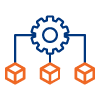Concierto Continues ASEAN Success: From Vietnam to…
Introduction
Most organizations wanting to migrate to the cloud are seeking agility, cost-efficiency, and operational excellence. But is that approach a reactive move, or is it a strategic decision that will define future success? That’s where you, as a professional services provider, must provide the solutions to ensure your customers enjoy not only a successful cloud migration but also continuous optimization of their new environment.
Organizations grapple with intricate engineering and business challenges—unforeseen delays, escalating costs, and operational disruptions due to inconsistent configurations during cloud migration. Whether they're navigating legacy systems or handling soaring cloud expenses, these obstacles can all too easily derail their plans.
What separates effective migrations from ineffective ones is strategic leadership supported by the right tools and practices. Successful migrations require alignment of assessment, execution, and ongoing optimization, which should deliver value for your customers before, during, and after the sale.
The Challenges of Legacy Cloud Migrations
When a company adopts new technologies and finds itself adapting to changes made by a third-party provider, there can be problems to tackle as part of the process, as opposed to on-premises infrastructure. Software and data, for instance, might not work properly or be accessible as expected after migration, which can disrupt operations and cause unwelcome chaos.
While companies naturally try to mitigate such issues, these challenges can seem overwhelming because traditional cloud migration is often ineffective, resource-intensive, and time-consuming.
Following are some of the most common cloud migration challenges organizations face:
Best practices for successful cloud migrations
In my experience, no two migrations are alike. Each set of legacy infrastructure has its quirks, crucial elements, and software destined for replacement. One of the most difficult parts of cloud migration is the assessment—understanding what the customer has, what they need to keep, and what can be upgraded or replaced. Sometimes, it feels a bit like cleaning out the attic!
The assessment and planning stage is the cornerstone of a successful migration. Contrary to popular belief, the assessment stage—not the cutover—is the root of every effective migration. This stage isn’t just about assessing legacy infrastructure; it’s where you and your customer align business objectives to infrastructure needs. Is the main goal to enhance security? Maybe the old cybersecurity software needs an upgrade. Reduce costs? Keep a close eye on duplicated and outdated assets. Enabling scalability? Time to evaluate the potential of cloud and hybrid cloud options.
When I meet with my customers, here is the approach I share with them:
Comprehensive assessment and planning
Understanding the “why” behind a migration effort is the first thing to grasp in order to provide a good migration experience for your customer. Once you and your customer have covered the why, your next step is to run a detailed assessment. In addition to discovering inventory, you also want to uncover:

Infrastructure inventory
Catalogue hardware, software, and workloads. You’re also seeking to identify resources that are either underutilized or overburdened.

End-of-life components
Are any hardware and software assets outdated and will require upgrades or replacement?

Dependencies
Take the time to map out application and workload interdependencies. Once you understand those, you’ll be able to reduce risks during migration.

Resource usage analysis
Especially if the business objective is scalability, take the time to evaluate the customer’s current performance metrics. This will help you ensure the target cloud environment is appropriately sized. The last thing you want is for the customer to pay for cloud capacity they don’t need.

Target suitability
Assess how well each application aligns with the target cloud environment’s scalability and performance requirements. This is where you circle back to the customer’s business goals for their new cloud environment.
Most professional services providers do this process manually. However, I recommend using an automated platform such as Concierto, which can save time and avoid human error during this critical phase.
Use automation to minimize errors
Speaking of automation, manual migrations face inherent limitations. While some prefer hands-on approaches, human intervention often becomes the bottleneck, introducing potential errors and slowing the process.
Automated migration platforms like Concierto MIGRATE ensure consistency while accelerating the process. Consider migrating large-scale enterprise applications with multiple interconnected services - manual dependency mapping could extend downtime and risk costly disruptions through human error.
Concierto streamlines the process by automatically grouping related applications and infrastructure into migration waves based on business priorities and dependencies. For instance, using AI-driven techniques, one customer achieved orchestrated migration of their Windows applications and MySQL databases in just five weeks while maintaining business continuity.
A customer recently raised a valid concern: "If workloads continue running during migration, won't data changes cause errors or inaccuracies?" This highlights the importance of continuous data synchronization during migration. When evaluating automated migration platforms, ensure they offer robust data sync capabilities to maintain data consistency throughout the process.
Avoid downtime with incident and change management
Despite even the best planning, unexpected issues during migrations can and do occur. And no one wants to derail a timeline because of an unforeseen issue. To maintain momentum during your customer’s migration, make sure the software you use offers robust incident and change management processes, which are especially necessary for hybrid environments.
Recently, a customer migrated an enterprise resource planning (ERP) system that integrates with multiple business units. That was a case where even minor disruptions, like delayed updates or team miscommunications, could lead to significant operational downtime affecting multiple departments. This highlights the importance of choosing migration platforms that provide real-time dashboards and role-based analytics. When teams have comprehensive visibility into the migration process, they can quickly identify potential issues before they escalate.
In case of unavoidable incidents, you’ll also want a solution that offers built-in incident management workflows so you can detect and address issues immediately and keep the migration project on track.
Enable proactive performance monitoring after go-live
Often, my customers are so focused on the initial migration that they don’t think too far beyond it. But the migration journey extends well beyond the initial go-live phase. After all, if the benefit of a cloud environment is its flexibility and scalability, you’ll want to be able to track and adjust your spend usage and spend continuously.
Post-migration monitoring ensures optimal workload performance in the new environment. By implementing robust cloud monitoring and optimization, organizations can shift from reactive troubleshooting to proactive management, addressing performance bottlenecks before they impact operations.
A successful migration isn’t enough; you must choose a solution that provides post-migration monitoring to provide your customers with comprehensive visibility into their new system’s health and performance. Real-time insights into critical metrics are also essential, along with features such as automated issue detection, and swift resolution capabilities.
For example, after the initial migration, one customer used Concierto MANAGE to monitor servers, achieving 35% faster diagnosis times and reducing incidents by 30% through automated issue detection and resolution.
Optimize costs with data-driven insights
One way to continue to provide service after the sale is to offer your customer a cost optimization solution. Cloud cost optimization represents a strategic opportunity that extends far beyond simple cost reduction. Combined with your professional services expertise, you can use cost optimization solutions such as Concierto Maximize to help your customer reshape their approach to resource allocation and financial management.
To do that, you must help your customer implement sophisticated FinOps practices from day one of migration. By combining AI-driven insights with proactive resource management, you can help your customer prevent the common pitfalls of over-provisioning while ensuring optimal performance. This strategic approach transforms traditional cloud cost management into a driver of business value.
This strategic approach to cost management positions organizations not just for successful migration, but for long-term cloud optimization and value creation.
Conclusion
In this post, I showed some of the best practices for helping your customers migrate to the cloud, including a detailed assessment phase, taking advantage of modern automation options, implementing strong incident management processes, and enabling system monitoring and optimization after go-live to keep the system efficient.
Migrating to the cloud is more than a technical shift—it's a strategic opportunity to drive efficiency, scalability, and cost optimization for your customers. By prioritizing thorough assessments, leveraging automation, and maintaining proactive monitoring and cost management practices, you can ensure a seamless migration and lasting value for their business. A successful migration isn’t just about moving workloads; it’s about empowering customers with solutions and strategies for ongoing performance and growth in the cloud.


